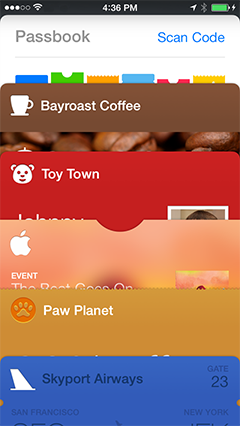
Microsoft’s Windows Phone 8.1 has a hidden trick that Apple might not be thrilled with.
Users can apparently download passes from Apple’s Passbook system and access them through Windows Phone’s Wallet app. This capability was discovered by Tom Warren of The Verge, who says it worked perfectly for boarding passes.
Passbook is Apple’s system for digital payment cards, loyalty cards, coupons and tickets. It allows iPhone users to pull up all their passes from one place instead of having to dig through multiple apps.
Although Windows Phone and Android offer similar services, they’re not as widely adopted by app developers as Passbook. Microsoft may be supporting Passbook passes as a way of filling the gap.
This isn’t the only case of Passbook being supported on other platforms. On Android, third-party apps such as Pass2U and PassAndroid can display Passbook passes as well.
As iMore points out, there’s nothing particularly special about the Passbook data itself. Passbook files are basically a package of web languages that the Passbook app reads and formats, so it seems Microsoft has simply found a way to read and format the same bits of code in its own Wallet app.
The special sauce for Apple is in the way cards are added and updated on users’ iPhones. Some apps allow users to add cards to their Passbooks by pushing a button within the app, but this option isn’t available through apps on other platforms. Instead, users can only download passes from an email or text message, or by scanning a barcode.
Also, Apple has its own system for pushing updated information (such as a gate change for a flight) to users’ devices. A third-party system may have to employ workarounds, such as periodic checks for updated info.
Maybe that explains why Apple hasn’t cracked down on other platforms’ use of Passbook. The experience just won’t be as good, and may end up luring people back to iOS.
Besides, neither Google nor Microsoft are advertising Passbook support as a key feature of their operating systems. If they did, it’d be kind of like when Palm advertised iTunes sync support for its Pre smartphone in 2009. Apple did take action in that case, prompting a cat-and-mouse game in which Palm tried (and ultimately failed) to get around Apple’s roadblocks.
More Must-Reads from TIME
- Donald Trump Is TIME's 2024 Person of the Year
- Why We Chose Trump as Person of the Year
- Is Intermittent Fasting Good or Bad for You?
- The 100 Must-Read Books of 2024
- The 20 Best Christmas TV Episodes
- Column: If Optimism Feels Ridiculous Now, Try Hope
- The Future of Climate Action Is Trade Policy
- Merle Bombardieri Is Helping People Make the Baby Decision
Contact us at letters@time.com